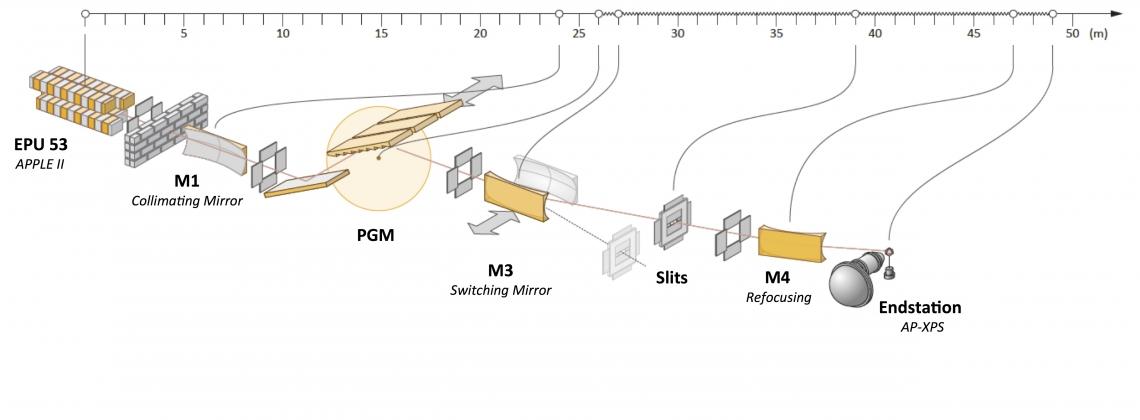HIPPIE is a state-of-the-art beamline for Ambient pressure X-ray photoelectron spectroscopy (APXPS). The combination of the exceptional performance of the 3 GeV ring with an innovative design of the experimental station results in a beamline which is outstanding not just in a pure electron spectroscopy context, but which also significantly expands the scientific issues that can be addressed. Thus HIPPIE will serve a much wider user community than the traditional electron spectroscopy one. The overarching objective of the HIPPIE beamline is to address the pressure and materials gaps, that is to relax the vacuum constraints, which traditionally have limited the processes and systems possible to study, and to move from model to real – and thereby often much more complicated – materials systems.
Experimental station
HIPPIE is designed for Ambient Pressure X-ray Photoelectron Spectroscopy (APXPS) offering the possibility of recording photoemission spectra at pressures up to 30 mbar (currently 10 mbar).
The endstation consists of the following chambers:
1. Analysis chamber.
2. Preparation chamber.
3. Load-lock chamber.
4. UFO distribution chamber.
5. Analyzer
6. Ambient-pressure experimental cell (AP Cell) which can be docked to the analyser
The analysis chamber is also equipped with a Bruker PM-IRAS instrument for simultaneous recording of APXPS and PM-IRAS at 1 mbar.
The composition of gas/vapour introduced in the AP cell and pumped out from it can be monitored by mass spectroscopy.
Sample
Manipulator or Sample stage
X, Y, Z translations.
55 deg synchrotron beam incidence (beam to surf normal).
Top (sample) manipulator X, Y, Z, R, motorised.
Bottom (beaker) manipulator X, Y, Z, motorised.
Sample Environment
E-beam heating (up to 900 C with stainless steel sample holders) heater operated by PID controller.
To enable photoemission measurements on catalytic and surface science type systems at mbar pressure range.
Small-volume (1 L) cell with controllable gas supply. Standard setup for general users.
Direct laser heating (CW, 1080 nm) of sample up to 600C at 30 mbar (PID controlled).
Ethanol chiller for cooling.
Automatic gas-dosing and mixing system for up to 8 gases (maximum flow rate 30 sccm).
Enables photoelectron spectroscopy at the solid-liquid and liquid-gas interfaces via use of dip-and-pull or liquid microjet methods
It is a large-volume vacuum vessel with two manipulators. Top manipulator holds the sample or microjet; bottom manipulator holds beaker or catcher. Cell access is done via 300 mm front load lock.
The cell can be equipped with Ar or N2-filled glove bag or glove box
The Vessel is equipped with halogen lamps for homogenous environment heating.
Beakers/catchers of up to 50 mm diameter and 60 mm height can be accommodated. Beakers of 30, 60, 100, and 150 ml volume are available.
Heating or cooling can be provided via temperature-controlled platform on which beaker stands.
A Bio-Logic SP200 potentiostat is available (ranges: +/- 10V and +/- 1 mA).
Storage of 6 samples inside load lock and 6 samples inside storage chamber.
Vacuum vessel with possibility to generate up to 1 bar gas pressure above sample's surface. Uses same heating and gas delivery/analysis system as the catalysis chamber (IR laser, 1080nm. Up to 600 C).
Prevac IS 40C1 sputter gun.
E-beam (up to 900 C with stainless steel sample holders) heater operated by PID controller.
Sample Holders
Sample holder can be easily removed from manipulator for electrode/sample exchange.
Nozzle size: 15 and 20 µm.
Sample loop: 10 ml.
Capillary mixing of 2 liquids.
Microjet manipulator is equipped with a heating/cooling jacket.
Catcher (bottom manipulator) size: 300 ml.
Catcher can be heated and cooled.
Analyzer detector
Spatial resolution: < 10 µm.
Sampling rate: 17/120 Hz
Transmission mode (with Swift acceleration)
Angular mode (18 deg acceptance)
Spatial mode
Detection
- NEXAFS
- Mass spectrometry
- XPS
- Other - Chemistry
- Sustainable energy systems
Fotongatan 2
224 84 Lund
Sweden
- TBC
- TBC
- TBC
